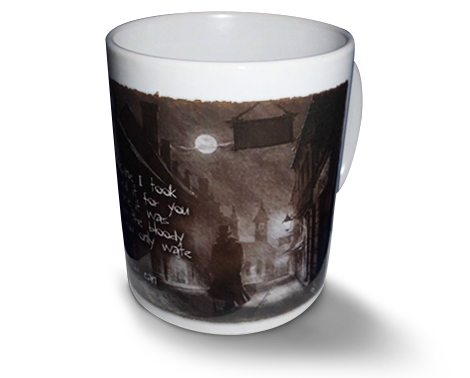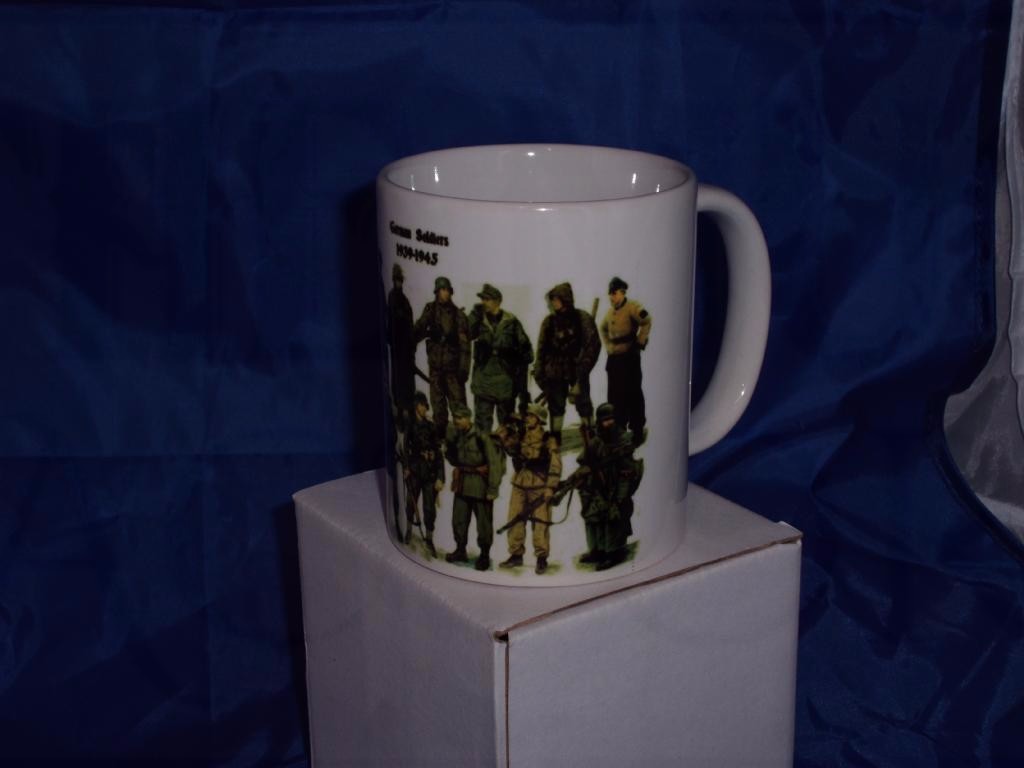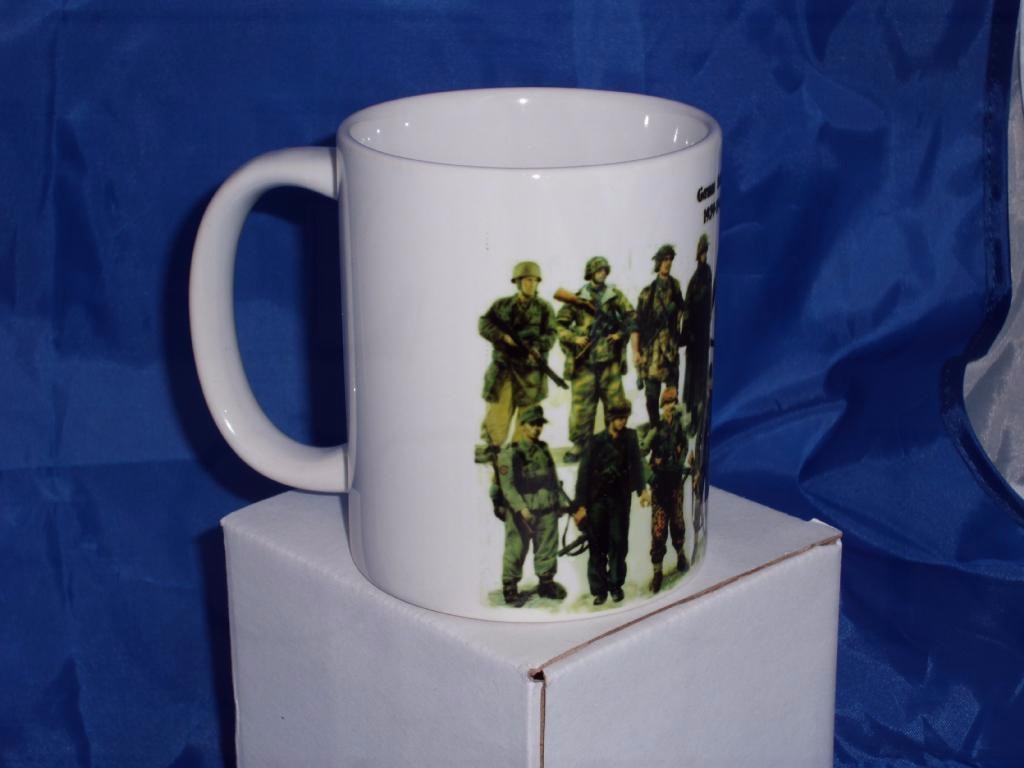WW2 German soldiers 1939 to 1945 military mug
Classic WW2 Coffee Mugs and Drinkware Available for Orders 11 oz mug.
After World War I ended with the armistice of 11 November 1918, the armed forces were dubbed Friedensheer (peace army) in January 1919. In March 1919, the national assembly passed a law founding a 420,000 strong preliminary army as Vorläufige Reichswehr. The terms of the Treaty of Versailles were announced in May, and in June, Germany was forced to sign the treaty which, among other terms, imposed severe constraints on the size of Germany's armed forces. The army was limited to one hundred thousand men with an additional fifteen thousand in the navy. The fleet was to consist of at most six battleships, six cruisers, and twelve destroyers. Submarines, tanks and heavy artillery were forbidden and the air-force was dissolved. A new post-war military (the Reichswehr) was established on 23 March 1921. General conscription was abolished under another mandate of the Versailles treaty.The limitions imposed by Versailles turned out to be a blessing in disguise for the military. That the Reichswehr was limited to 100,000 men ensured that under the new leadership of Hans von Seeckt that the Reichswehr kept only the very best officers. The American historians Alan Millet and Williamson Murray wrote "In reducing the officers corps, Seeckt chose the new leadership from the best men of the general staff with ruthless disregard for other constituencies, such as war heroes and the nobility". Seeckt's determination that the Reichswehr be an elite cadre force that would serve as the nucleus of an expanded military when the chance for restoring conscription came essentially led to the creation of a new army, based upon, but very different from the army that existed in World War I. Though Seeckt retired in 1926, the army that went to war in 1939 was largely his creation. In the 1920s, Seeckt and his officers developed new doctrines emphasizing speed, aggression, combined arms and initiative on the part of lower officers to take advantage of momentary opportunities. Germany was forbidden to have an air-force by Versailles, but Seeckt who saw the advantages of air-warfare created a clandestine cadre of air-force officers in the early 1920s. Seeckt's cadre of secret air-officers saw the role of an air-force as winning air-superiority, tactical and strategic bombing and providing ground support. That the Luftwaffe did not develop a strategic bombing force in the 1930s was not due to a lack of interest, but because of economic limitations. The leadership of the Navy led by Grand Admiral Erich Raeder, a close protégé of Alfred von Tirpitz was dedicated to the idea of reviving Tirpitz's High Seas Fleet. Officers who believed in submarine warfare led by Admiral Karl Dönitz were in a minority before 1939. Naval officers saw war almost entirely in tactical and technological terms, and had almost no interest in operational matters.By 1922, Germany had begun covertly circumventing these conditions. A secret collaboration with the Soviet Union began after the treaty of Rapallo. Major-General Otto Hasse traveled to Moscow in 1923 to further negotiate the terms. Germany helped the Soviet Union with industrialization and Soviet officers were to be trained in Germany. German tank and air-force specialists could exercise in the Soviet Union and German chemical weapons research and manufacture would be carried out there along with other projects. Around 300 German pilots received training at Lipetsk, some tank training took place near Kazan and toxic gas was developed at Saratov for the German army.Adolf Hitler and reinstatement of conscriptionAfter the death of President Paul von Hindenburg on 2 August 1934, Hitler assumed the office of Reichspräsident, and thus became commander in chief. All officers and soldiers of the German armed forces had to swear a personal oath of loyalty to the Führer, as Adolf Hitler was called. By 1935, Germany was openly flouting the military restrictions set forth in the Versailles Treaty, and conscription was reintroduced on 16 March 1935.While the size of the standing army was to remain at about the 100,000-man mark decreed by the treaty, a new group of conscripts equal to this size would receive training each year. The conscription law introduced the name Wehrmacht, so not only can this be regarded as its founding date, but the organization and authority of the Wehrmacht can be viewed as Nazi creations regardless of the political affiliations of its high command (who nevertheless all swore the same personal oath of loyalty to Hitler). The insignia was a simpler version of the Iron Cross (the straight-armed so-called Balkenkreuz or beamed cross) that had been used as an aircraft and tank marking in late World War I, beginning in March and April 1918. The existence of the Wehrmacht was officially announced on 15 October 1935.NumbersThe total number of soldiers who served in the Wehrmacht during its existence from 1935–1945 is believed to have approached 18.2 million. This figure was put forward by historian Rüdiger Overmans (de) and represents the total number of people who ever served in the Wehrmacht, and not the force strength of the Wehrmacht at any point.German Command structureFurther information: Wehrmacht and National SocialismLegally, the Commander-in-Chief of the Wehrmacht was Adolf Hitler in his capacity as Germany's head of state, a position he gained after the death of President Paul von Hindenburg in August 1934. In the reshuffle in 1938, Hitler became the Supreme Commander of the Armed Forces and retained that position until his suicide on 30 April 1945. Administration and military authority initially lay with the war ministry under Generalfeldmarschall Werner von Blomberg. After von Blomberg resigned in the course of the Blomberg-Fritsch Affair (1938), the ministry was dissolved and the Armed Forces High Command (Oberkommando der Wehrmacht or OKW) under Generalfeldmarschall Wilhelm Keitel was put in its place. It was headquartered in Wünsdorf near Zossen, and a field echelon (Feldstaffel) was stationed wherever the Führer's headquarters were situated at a given time. Army work was also coordinated by the German General Staff, an institution that had been developing for more than a century and which had sought to institutionalize military perfection.OKW coordinated all military activities but Keitel's sway over the three branches of service (army, air-force, and navy) was rather limited. Each had its own High Command, known as Oberkommando des Heeres (OKH, army), Oberkommando der Marine (OKM, navy), and Oberkommando der Luftwaffe (OKL, air-force). Each of these high commands had its own general staff. In practice the OKW had operational authority over the Western Front whereas the Eastern Front was under the operational authority of the OKH.Flag for the Commander-in-Chief of the German Armed Forces (1935–1938).Supreme High Command of the Armed Forces (OKW) Supreme Commander of the Armed Forces Führer and Reichskanzler Adolf Hitler (1935–1945)Großadmiral Karl Dönitz (1945)Commander-in-chief of the Armed Forces Generalfeldmarschall Paul von Hindenburg (1933–1934), President of the ReichFührer and Reichskanzler Adolf Hitler (1934–1935)Generaloberst Werner von Blomberg (1935–1938), Minister for War, promoted Generalfeldmarschall (1936) vested into the Supreme Commander (theoretically) and the Chief of the Supreme High Command (practically)Vice Commander-in-chief of the Armed Forces General Werner von Blomberg (1933–1935), promoted Generaloberst 1933Chief of the Armed Forces Supreme High Command—Generalfeldmarschall Wilhelm Keitel (1938–1945)Chief of the Operations Staff (Wehrmachtführungsstab)—Generaloberst Alfred JodlSupreme High Command of the Army (OKH) Army Commanders-in-Chief Generaloberst Werner von Fritsch (1935–1938)Generaloberst Walther von Brauchitsch (1938–1941), promoted to Generalfeldmarschall 1940Führer and Reichskanzler Adolf Hitler (1941–1945)Generalfeldmarschall Ferdinand Schörner (1945)Chiefs of Staff of the German Army General Ludwig Beck (1935–1938)General Franz Halder (1938–1942)General Kurt Zeitzler (1942–1944)Generaloberst Heinz Guderian (1944–1945)General Hans Krebs (1945, committed suicide in the Führerbunker)Supreme High Command of the Navy (OKM) War Navy Commanders-in-Chief Admiral Erich Raeder (1928–1943), promoted to Generaladmiral 1936, Großadmiral 1940Großadmiral Karl Dönitz (1943–1945)Generaladmiral Hans-Georg von Friedeburg (1945)"Admiral Inspector": Großadmiral Erich Raeder (1943–1945) (sinecure)Supreme High Command of the Air-Force (OKL) Air-Force Commanders-in-Chief General Hermann Göring (1935–1945), promoted Generaloberst 1936, Generalfeldmarschall 1938 (!), Reichsmarschall (singularily) 1940Generalfeldmarschall Robert Ritter von Greim (1945)







